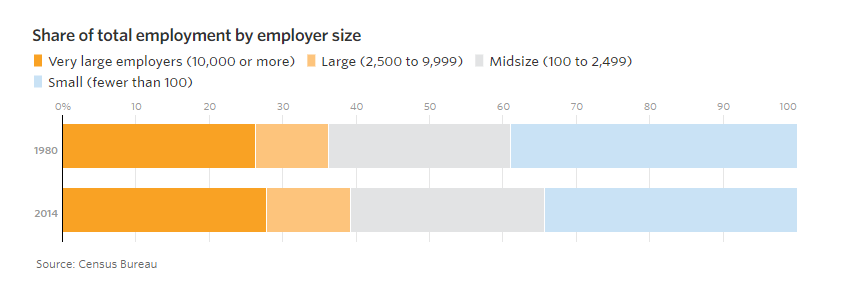Re: Higgenbotham's Dark Age Hovel
Posted: Sat Aug 12, 2023 11:30 am
There is an update at the bottom from a news article published today.
Higgenbotham wrote: Mon Jun 26, 2023 2:00 am Here is some data on what has happened since Micron Technology was founded in 1978.
Under Ronald Reagan, who was in office from 1981 to 1989, there was a push to encourage small business formation, and the gap between the number of employees in small businesses versus large businesses widened to the widest gap on the chart in favor of small businesses. It remained approximately steady under George Bush. Once Clinton entered office in 1993, the gap completely closed and when Clinton left office more Americans worked for large businesses for the first time. Under the younger George Bush, once again, there was little change. When Obama entered office in 2009, once again, large businesses were favored and the gap widened even more in favor of large businesses to its widest gap on the chart in favor of large businesses.
https://www.wsj.com/graphics/big-companies-get-bigger/Americans, in a generational reversal, are now more likely to work for a large employer than a small one, a shift that’s rippling through the economy.
By Theo Francis
Published April 6, 2017 at 10:45 a.m. ET
The United States has long held itself out as a nation driven by entrepreneurs and small businesses. Presidents and politicians still invoke that image, and for generations, it was largely accurate.
Today, the U.S. has become something different: a nation of employees working for large companies, often very large ones.
In the late 1970s, an American employee was more likely to work at a company with fewer than a hundred workers than one that employed 2,500 or more. Today, Americans are more likely to work for the larger firms.
More than a quarter of all U.S. employees worked at firms employing at least 10,000 people in 2014, the most recent year for which the Census Bureau has released comprehensive data.
Huge companies dominate American economic life well beyond employment. They ring up a disproportionate share of sales for goods and services, both to consumers and to other businesses.
Scale alone isn’t bad. It can bring substantial efficiencies. National cellular providers can spare customers the complexity and expense of roaming charges. At the same time, scale begets scale as big companies reinforce one another. Big retailers prefer big distributors. Big manufacturers need big suppliers.
Over time, economists say, nimble new companies should form to challenge sprawling incumbents. That isn’t happening as much these days. Young firms often fail or are absorbed by existing giants. The problem now is that business formation has slowed.
https://www.msn.com/en-us/money/savinga ... f4f7e&ei=7The Chicago school economist who warned years ago of America’s ‘business dynamism’ fading still sees ‘something broken in the background’
Story by Rachel Shin •4h
Ufuk Akcigit is a distinguished economist. He’s the Arnold C. Harberger professor of economics at the University of Chicago, one of the most influential departments in the discipline of the last century (the so-called “Chicago school”), and holds a PhD from MIT. The Turkish national has also won multiple awards for his research, including Germany’s Max Planck-Humboldt and Kiel Institute awards, as well as the prestigious Guggenheim Fellowship.
A pioneer in the field of Quantitative Economic Growth, Akcigit examines how market innovation and policy combine to optimize an economy’s expansion—or the opposite. Akcigit’s work on “business dynamism,” a hugely important metric that gauges an economy’s ability to sustain growth, has borne grim tidings for his adopted country of the United States. Simply put, he’s found that over time, the American economy has become a hostile environment for innovation.
In 2019, Akcigit and his co-author Sina T. Ates, of the Federal Reserve Board, released findings that pinned the blame for fading U.S. dynamism on “poor knowledge diffusion.” Four years later, he tells Fortune that the problems just haven’t gone away.
“For productivity to improve, we need to have ‘creative destruction’ and turnover,” Akcigit told Fortune. “Better firms should replace worse firms in the economy, and that turnover will push productivity forward.”
(Ates, a principal economist at the Federal Reserve Board, was unable to speak on the record due to his position. The researchers’ findings do not reflect the opinion of the Fed.)
Something’s broken
Business dynamism, measured by the rate of new firm creation in markets, is directly tied to innovation and productivity. In Akcigit’s field, researchers have known that it’s been declining in the U.S. since the 1980s, the cause of which has prompted various theories. This decline in dynamism is significant because it’s linked to a general slowing of productivity and creative momentum, which need to be strong for the U.S. to remain the world’s dominant economy in the long term.
The majority of U.S. markets have become more concentrated, and thus less competitive due to the slowing firm turnover rate, the co-authors argued. The result has been markets increasingly dominated by big players who don’t drive their sectors forward, and higher barriers for new businesses to enter markets. The dip in new entrants is a hit to the economy, as new entrepreneurs are the engines of growth under capitalism.



